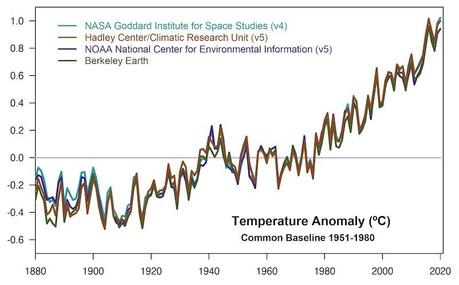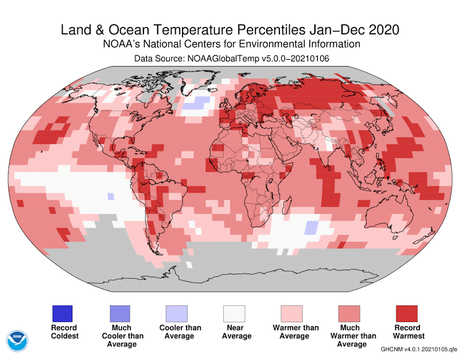For many of us, 2020 was without a doubt the worst year that we can remember. After all, a global pandemic forced us to stay close to home, cancelled countless projects and events, and claimed the lives of more than 2 million people worldwide. Add in political unrest, racial tensions, an economic meltdown, and an overwhelming sense of isolation, and it is easy to see how anyone could think that it couldn't possibly have been any worse.
But last week NASA released climate data that indicated that despite lockdowns, a lack of travel, and a shutdown of heavy industry in many parts of the world, 2020 was tied for the hottest year on record. In other words, even with all of the challenges that last year brought, climate change and global warming remain the Sword of Damocles hanging over all of our heads.
Our Warming World
Over the past few decades scientists and climatologists have seen an undeniable trend when it comes to the average temperature of our planet. According to the most recent research from NASA, in 2020, that trend continued with temperatures rising across the globe. That data indicates that it was so warm throughout the year that 2020 was technically the hottest on record. But, because the stats from 2016 fell within the statistical margin of error, the two years were declared tied for this dubious distinction.
Global climate data and temperature records have been closely monitored since the early 1950s. In fact, the baseline from which all temperature models are compared was set over 30 years of data collected from 1951 to 1980. During that time, global temperatures held fairly steady, with only an occasional-and temporary-shift here and there. That hasn't been the case since the 80's however, which is when the warming trend first began to take root.
NASA's report indicates that 2020 was 1.84 degrees Fahrenheit (1.02 degrees Celsius) warmer than the historical baseline. That's still below the 2ºC tipping point outlined in the Paris Agreement, but it is still enough to alarm researchers.
Past the Point of No Return?
While the 2ºC barrier continues to be seen as the point of no return, some scientists believe we may already be approaching that point. There are some indications that even an increase of 1.5ºC would have a catastrophic impact on the ice sheets of Greenland. Trends show that we could reach that mark by as early as 2030, resulting in a massive melt off that could cause ocean levels to rise by as much as 13 meters (43 feet). The devastation that would cause worldwide is enormous.
Gavin Schmidt, who is the director of the Goddard Institute for Space Studies says, "The last seven years have been the warmest seven years on record, typifying the ongoing and dramatic warming trend." The GISS has been instrumental in collecting climate change data, prompting Schmidt to remark, "Whether one year is a record or not is not really that important - the important things are long-term trends. With these trends, and as the human impact on the climate increases, we have to expect that records will continue to be broken."

Data Collected From Across the Globe
In creating its annual report on the healthy of the planet, NASA pulls data from a dizzying array of sources. Researchers crunch the numbers from more than 26,000 weather stations from every corner of the planet. They also collect information from thousands of ships and weather buoys at sea, which helps to present a broad picture of climate and temperature trends. Add in a fleet of aircraft and satellites that observe shifting climate conditions as well, and you end up with terabytes of data to be analyzed.
The numbers are run through an algorithm that accounts for the location of the weather stations, as well as variables such as urban heating effects or unusual spikes or dips in temperature. The result is a global average that tracks the planet as a whole, rather than numerous individual points on its surface.
2020 vs 2016
Despite the fact that 2020 technically tied with 2016 for the title of hottest year on record, there are some important distinctions to be made between these two years. The most significant of those differences is that 2016's warming trend was aided by a strong El Nino effect, which tends to bring higher temperatures along with it. In 2020, El Nino was actually in its cooling phase, which meant the jump in overall warmth could have been a lot worse.
The COVID-19 pandemic may have played a role in actually causing temperatures to rise as well. With many industrial centers closed down for weeks at a time, the skies over head were visibly clearer. That meant that there was less particulate in the air, which has led some researchers to speculation that this could have allowed more sunlight to pass through, causing the mercury to rise as a result.

Perhaps the biggest take away rom the NASA report is that the seven year trend of warming temperatures isn't just continuing-its accelerating. On a global level, temperatures are rising at a faster pace, with the Arctic especially being impacted. The polar regions of our planet are warming at three times the pace found elsewhere, which is reducing the overall size of the ice caps by 13% per decade. In the past, that ice helped reflect some of the sun's heat back out of the atmosphere, but as it shrinks in size it become less effective at doing that.
It is stories like these that remind us of the interconnected nature of our planet and how changes in the Arctic can cause warming trends to speed up in other parts of the world. That also means that this won't be an easy challenge to overcome or solve. Hopefully it isn't too late to reverse these trends, which threaten to dramatically and fundamentally change life as we know it on this planet.

